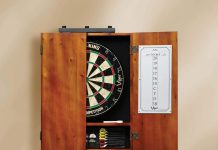Hello there! Have you ever wondered what that mysterious line on the floor is when playing darts?
That’s right, we’re talking about the throw line! In the exciting world of darts, the throw line ensures fair play and maintains the appropriate distance between players and the dartboard.
But what exactly is the throw line, and why is it so important? Let’s find out!
Review contents
Definition of the Throw Line
The throw line, also known as the “oche,” is a line that marks the distance from which a player must throw their darts in the game of darts. It is a guideline to ensure fair play and maintain consistency across games. The throw line is a crucial element in darts, as it determines the distance between the player and the dartboard, influencing the accuracy and skill required to hit the target.
Origin and Purpose
The origin of the throw line can be traced back to the game’s early days, when players would draw a line on the ground or use a physical marker to establish a consistent throwing position. The throw line aims to create a standardized starting point for all players, promoting fair competition and ensuring a level playing field.
Standard Distance
The standard distance from the dartboard to the throw line is 7 feet 9 1/4 inches, or 2.37 meters. This distance is measured horizontally from the face of the dartboard to the closest edge of the throw line. It is crucial to maintain this standardized distance to maintain the integrity of the game and provide equal opportunities for all players.
Varied Throw Line Names
Different regions and communities may use various names to refer to the throw line. In some areas, it is commonly called the “oche,” derived from the term used in the traditional pub game of darts. Other names for the throw line include “toe line,” “foul line,” or simply “throwing line.” Although the names may vary, the purpose and function remain consistent.
Different Types of Throw Lines
Depending on personal preference or tournament regulations, throw lines can come in different shapes and sizes. The two most common throw lines are the static and movable throw lines. The static throw line is a permanent marker on the floor, often made of tape or paint. In contrast, a movable throw line can be attached to the floor and easily adjusted to meet the required distance. Both types serve the same purpose of providing a clear and visible throwing position for the players.
Regulations and Dimensions
Official Dart Regulations
The governing body for darts, the World Darts Federation (WDF), has established official regulations and dimensions for the throw line. These regulations ensure consistency and fairness across competitive games. Players must familiarize themselves with these regulations when participating in tournaments or organized competitions.
Distance from Floor
According to the official dart regulations, the height of the throw line, or oche, from the floor should be precisely 1.73 meters. This ensures consistency in the measurement, allowing players to have a standardized throwing position regardless of the venue or dartboard setup.
Distance from Dartboard
As mentioned earlier, the standard distance between the dartboard and the throw line is 7 feet 9 1/4 inches, or 2.37 meters. This measurement ensures a fair and equal playing field for all players, providing a consistent challenge regardless of their skill level.
Other Regulations
In addition to the specific measurements, there are other regulations players must adhere to when it comes to the throw line. For example, players must not cross or step on the throw line before releasing their darts. Violating this rule may result in a foul or loss of points. Additionally, players should maintain proper etiquette, such as not obstructing the view of other players and not interfering with their opponent’s throws.
Throw Line Markings
Traditional Throw Line
The traditional throw line is marked on the floor, usually with tape or paint. It is a permanent marker commonly found in pubs, clubs, or home setups. The traditional throw line is a straightforward and cost-effective way to establish a fixed throwing position without additional equipment.
Raised Throw Line
A raised throw line, often made of wood or metal, is an alternative to the traditional floor marking. It offers a more prominent and visually distinct throwing position. The raised throw line provides a physical barrier that prevents players from crossing the line during their throw, ensuring fairness and discipline in the game.
Removable Throw Line
A removable throw line is a convenient option for players who prefer flexibility in their setup. These throw lines typically consist of adhesive strips or decals that can be temporarily affixed to the floor. Removable throw lines provide easy installation and removal without leaving permanent marks or damage.
Throw Line Stickers
Throw line stickers are an excellent option for players who seek versatility and customization. These adhesive decals or stickers can be placed on the floor, allowing players to adjust the throw line position as desired. Throw line stickers come in various shapes and designs, enabling players to personalize their throwing area while adhering to the regulations.
Materials Used
Tape
Tape is a popular and cost-effective material for marking the throw line. Electrical, duct, or specialized dart tape can create a visible and durable throw line. Tape is easily accessible and can be applied and removed with minimal effort, making it a convenient choice for home setups or venues where the throw line needs to be adjusted regularly.
Paint
Paint is a more permanent solution for creating a throw line. Its durability and longevity make it suitable for venues with consistent dartboard installations. Painted throw lines require careful measurement and precision during installation but provide a clear and well-defined throwing position.
Adhesive Decals
Adhesive decals, commonly made of vinyl or plastic, are an excellent choice for players who prefer a removable and customizable throw line. These decals can be easily applied and removed without leaving residue or damaging the floor surface. Adhesive decals also come in various designs and sizes, allowing players to add a personal touch to their throwing area.
Rubber
Rubber throw lines provide a tangible and tactile sensation for players. These throw lines are often made of high-density rubber or silicone, creating a physical barrier that players can feel under their feet. Rubber throw lines offer stability and prevent slipping, enhancing the player’s confidence and comfort during the throw.
Methods to Create a Throw Line
Using Measuring Tape
Creating a throw line using a measuring tape is a straightforward method that ensures accuracy. Start by measuring the official distance of 7 feet 9 1/4 inches (2.37 meters) horizontally from the face of the dartboard. Mark the measurement on the floor using tape, paint, or preferred markers. Check the alignment regularly to ensure the throw line remains perpendicular to the dartboard.
Using a Professional Dart Mat
A professional dart mat is convenient and reliable for creating a throw line. These mats are pre-marked with the official distance and provide an accurate and stable platform for throwing darts. They often come with additional features such as non-slip surfaces and toe lines, further enhancing the player’s experience.
Utilizing a Throw Line Laser
For players who seek innovation and technology, a throw line laser is an exciting tool to create a precise throw line. These laser devices project a visible line onto the floor, allowing players to accurately adjust and align their throwing position. Throw line lasers are beneficial in environments where traditional markers may be impractical or require frequent adjustments.
Throw Line Etiquette
Position of Feet
Proper positioning of the feet is essential when abiding by throw line etiquette. Players should maintain a steady and balanced stance, aligning their feet parallel to the throw line. This position ensures stability and provides a consistent base for accurate throws.
Stepping on the Line
By the rules and regulations of darts, players must avoid stepping on or crossing the throw line while throwing their darts. Stepping on the line before releasing the dart is considered a foul and may result in penalty points or disqualification. It is crucial to practice self-discipline and ensure the entire foot remains behind the throw line during the throw.
Crossing or Overlapping the Line
Players should avoid crossing or overlapping the throw line with their foot or any part of their body during or after the throw. This etiquette maintains fairness and respect for the game and prevents any potential advantages or disadvantages for players.
Behavior in Competitive Play
In competitive play, players are expected to exhibit good sportsmanship and fair play. This extends to respecting the throw line and adhering to the regulations and etiquette. Players should refrain from intentionally obstructing or distracting their opponents during their throws and follow any additional rules or guidelines set by the tournament or organizing body.
Throw Line Variations in Different Dart Games
501
In the game of 501, which is one of the most popular dart games, the throw line regulations remain the same as the standard distance of 7 feet 9 1/4 inches (2.37 meters). The throw line is the starting point for each player to reach zero from 501 through strategic dart throws.
Cricket
In Cricket, another commonly played dart game, the throw line distance is the same as in 501. However, Cricket introduces the concept of a “batting line” or “throwing line,” which is the area players must aim for on the dartboard to score points. The throw line in Cricket remains the same, but the strategic aim may differ depending on the state of the game.
Around the Clock
Around the Clock is a game that requires players to hit each number on the dartboard in numerical order, starting from 1 and progressing clockwise. The throw line distance remains the same as the standard, but the aim and strategy focus on hitting the designated number on each turn.
Killer
Killer is a game that involves eliminating opponents by hitting specific targets on the dartboard while avoiding other areas. The throw line distance remains consistent, but the focus shifts to accuracy and target selection rather than reaching a specific score.
Throw Line Enhancements and Accessories
Throw Line Lights
Throw line lights are an exciting and visually appealing accessory that adds ambiance to a game of darts. These lights are installed on or around the throw line, illuminating the area and providing a unique atmosphere. Throw line lights can enhance the player’s focus and concentration, creating an immersive and enjoyable playing experience.
Throw Line Measurer
A throw line measurer is a handy tool for accurately measuring and adjusting the throw line when setting up a dartboard. Measurers come in various forms, such as a retractable tape or a measuring stick. The throw line measurer ensures consistency and allows quick and effortless adjustments to meet the required regulations.
Throw Line Toe Line
A throw line toe line is an additional marking placed in front of the throw line, serving as a reference point for the player’s leading foot. This accessory helps ensure consistent foot positioning and can help players maintain proper balance and stability during throws.
Common FAQs about the Throw Line
What is the distance from the dartboard to the throw line?
The standard distance from the dartboard to the throw line is 7 feet 9 1/4 inches, or 2.37 meters. This measurement is consistent across official dart regulations to maintain fairness and a level playing field.
Are there any regulations regarding throw line width?
Official dart regulations do not specify any regulations regarding the width or thickness of the throw line. The focus is primarily on the accurate placement and distance from the dartboard.
Can I make my throw line?
Yes, you can create your throw line using various materials and methods, such as tape, paint, adhesive decals, or rubber. Ensure that your self-made throw line adheres to the official regulations regarding distance and position.
Can I use any material for a throw line?
While there are various materials you can use for a throw line, it is essential to consider visibility, durability, and adherence to the regulations. Materials such as tape, paint, adhesive decals, and rubber are commonly used and provide suitable options for creating a throw line.
Conclusion
The throw line, or oche, holds significant importance in darts. It serves as a standard reference point for players, ensuring fairness and consistency across games. By maintaining the correct distance and adhering to the regulations, players can focus on improving their skills and enjoying the competitive and exciting world of darts.
Whether using traditional markings, innovative accessories, or personal preferences, the throw line remains an integral part of the dart-playing experience.























![Best Outdoor Dartboards [Reviews and Buying Guide 2024] Best Outdoor Dartboards](https://gamersets.com/wp-content/uploads/2022/12/Best-Outdoor-Dartboards-100x70.jpg)

![Best Mini Air Hockey Table [Reviews & Buying Guide 2024] Best mini air hockey table](https://gamersets.com/wp-content/uploads/2022/10/Best-mini-air-hockey-table-100x70.jpg)







